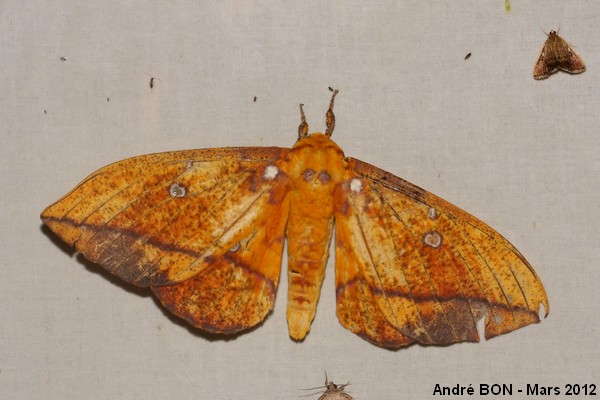
| Eacles penelope (Cramer, 1775) |

|
|
Scientific name: Eacles penelope (Cramer, 1775) Common name: French name: Order: Lepidoptera Suborder: Heterocera Family: Saturniidae Subfamily: Ceratocampinae Wingspan: 185 mm. Biotope: Geographic area: South America, including Ecuador, French Guiana and Brazil. Flight time: All year round. Number of generations : Caterpillar: At the last instar, green with reddish dots, white spiracles, brown reddish dorsal scoli and a brown patch close to the rear. Host plant: |
Eacles penelope is a large orange yellow Saturniidae with brown reddish markings. There are two round white spots, outlined with brown, on the upper side of the thorax. The costal edge of the fore wings is curved just before the apex like on many members of the same genus. The marginal edge of males' fore wings is rather straight, even slightly convex, before being rounded at the anal angle. You can use this feature to tell Eacles penelope apart from the members of the same genus which show a concave marginal edge. There is a dark line running from the apex of the fore wing to the two third of the inner edge. It continues on the hind wings from the costal edge to the inner edge. Males' fore wings show a brown greyish patch between this line and the margin. There is a silvery white discal spot, outlined with brown, on each wing. The ones on the fore wings are accompanied by a smaller spot next to the costal edge. Males bear a small silvery white spot, outline with brown, very close to the base on the fore wings. It is followed by a dark brown zigzag line. I have never observed this spot with this line on pictures of other species in this genus (so I am using this criteria to confirm the species identification - the relevance of this criteria requires confirmation ...) |
| [To know more about the Eacles penelope] [Top] |

|
I have shot this picture at Roura, at Camps Patawa, during a light trap night session. I have listed this one as Eacles penelope based on the shape of the fore wings and based on the white patch at the base of the fore wings. |